- Scientific name: Schoenoplectus torreyi (Olney) Palla
- Synonyms: Scirpus torreyi
- Species of Greatest Conservation Need (MA State Wildlife Action Plan)
Description
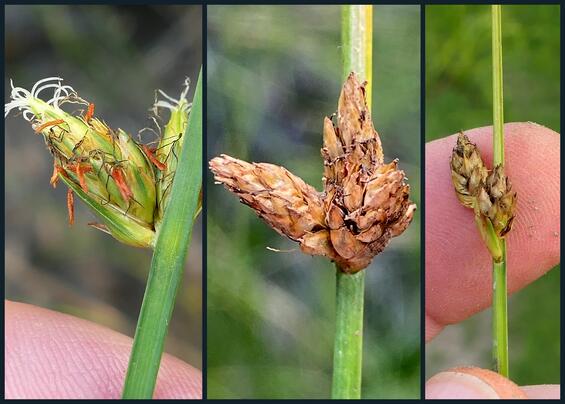
Inflorescence
Schoenoplectus torreyi is an herbaceous perennial that grows in fresh, calm, shallow waters in colonies of tall, triangular green stems. The stems typically extend 0.45-0.91 m (1.5-3 ft) above the water, with a total height ranging from 0.4-1.5 m (16-59 in) and a width of 1.5-5 mm (0.06-0.2 in). Reproductive stems have a small, sessile cluster of 1 to 4 spikelets near the tip, with spikelets measuring 7-18 mm (0.5-0.75 in) long. Most stems are not reproductive. The cluster of spikelets is subtended by a bract that is 3-20 cm (1-8 in) long. The bract appears as a continuation of the stem, making the inflorescence look as if it emerges from the side of the stem. There are 3 to 7 leaves, with the lowest being bladeless. The upper 3 to 6 leaves are stiff, V-shaped, up to 2 mm (0.08 in) wide, and can be as long as the stem. From a distance, these narrow emergent leaves can be mistaken for non-reproductive stems. The achenes are brown, compressed trigonous, and urn-shaped in outline, measuring 3.5-4.5 mm (0.14-0.18 in) in length and 1.7-2 mm (0.07-0.08 in) in width, with a beak that is 0.5-1 mm (0.02-0.04 in) long. The floral scales measure 4-5 mm (0.16-0.2 in) in length and 2.5 mm (0.1 in) in width. They are straw to orange-brown in color, sometimes with a greenish center. The scale tapers to the tip where the midrib extends into a short, mucronate awn, 0.2-0.5 mm (0.01-0.02 in) long.
Schoenoplectus torreyi can be easily confused with Schoenoplectus americanus and Schoenoplectus pungens. They are all roughly the same size with triangular stems, and a sessile cluster of spikelets that appear to emerge from the side of the stem. The latter two are much more common than S. torreyi. The floral scale is the simplest way to distinguish S. torreyi from the other two. The scale of S. torreyi has the midrib extending to a small mucronate awn. Both S. americanus and S. pungens have a notch in the margin of the scale on both sides of the awn. The lobes of the notch taper to a point giving the impression of a central awn flanked by two others. On S. americanus, the central awn is shorter than the notch lobes, while on S. pungens, the central awn is taller than the notch lobes.
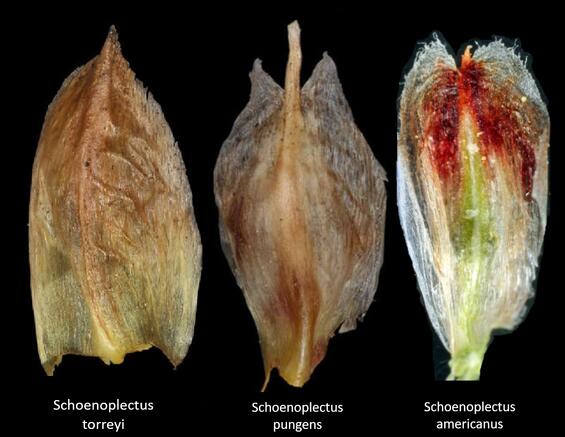
Comparison of the floral scales of look-alike species.
- Schoenoplectus torreyi floral scale ©MinnesotaWildflowers.info
- Schoenoplectus pungens floral scale ©MinnesotaWildflowers.info
- Schoenoplectus americanus floral scale from Western New Mexico University Department of Natural Sciences; wnmu.edu/gilaflora/.
Life cycle and behavior
This is a perennial growing from rhizomes in fresh, calm, shallow water of lakes, ponds, rivers and marshes. It can also inhabit large vernal pools forming a near monoculture dense stand. Fruits maturing by late-August.
Population status
MassWildlife’s Natural Heritage & Endangered Species Program (NHESP) database has 10 records from 8 counties across the state, not including Dukes, Hamden, Nantucket, Plymouth and Suffolk. Only 5 of those records are within the last 25-year period. iNaturalist has 3 research grade locations for this species in Massachusetts and an additional 4 locations elsewhere in New England.
Distribution and abundance
According to Biota of North America Program (BONAP), this species is present in most New England counties. It ranges from eastern Canada, south to Virginia, and west to South Dakota. The Consortium of Northeastern Herbaria website shows collections made between 2000 and 2024 from 6 unique locations in Massachusetts, 2 from Connecticut, 2 from Rhode Island, 1 from New Hampshire, and 3 from Maine. It’s considered rare, threatened, or critically imperiled in each New England state, except Maine where it is uncommon (Arsenault et al. 2013). Globally it is ranked a G4, or apparently secure (NatureServe 2025), despite iNaturalist having only 128 research grade observations worldwide, all in North America.
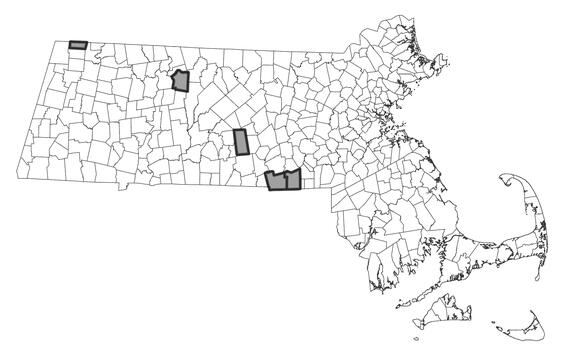
Distribution in Massachusetts
1999-2024
Based on records in the Natural Heritage Database
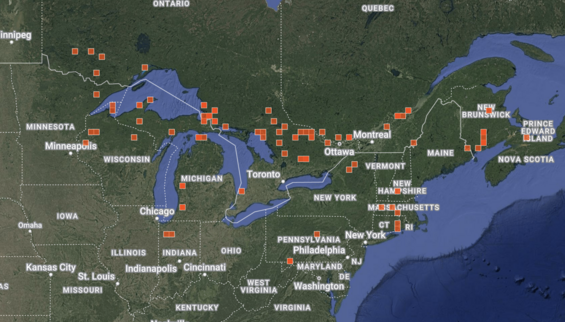
iNaturalist Research Grade Observations
Habitat
Grows throughout the state in fresh, calm, shallow waters of lakes, ponds, rivers, marshes, and seasonally inundated wetlands.
Healthy habitats are vital for supporting native wildlife and plants. Explore habitats and learn about conservation and restoration in Massachusetts.
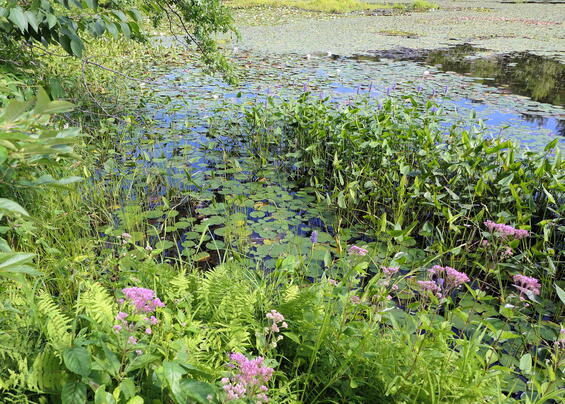
Pond habitat
Threats
The species seems to thrive as the edges of shallow lakes and ponds as well as in vernal pools that dry up in summer, suggesting that at least seasonal inundation is required. Potential threats may include prolonged drought or loss of habitat due to dam removal.
Conservation
Survey and monitoring
This is a long-lived perennial species and occurs where habitats are relatively stable. Surveys do not need to be more frequent than every five years and will be beneficial in part to check that hydrologic conditions are relatively unchanged.
Management
Management will largely be concerned with water level maintenance, control of invasive species, and making sure development does not occur in a manner that would allow soil erosion to deposit soil or mud into the water basin where this rare species occurs.
Research needs
Little has been done in the past to gather high quality locational data within given sites, as well as stem counts, seed counts, seed germination, expansion or contraction of colonies or rhizomatous clones and clusters. This information should be included in future surveys.
Acknowledgements
MassWildlife acknowledges the expertise of Douglas E. McGrady, who contributed substantially to the development and content of this fact sheet including photographs and images.
References
Arsenault Matt, Glen H. Mittelhauser, Don Cameron, Alison C. Dibble, Arthur Haines, Sally C. Rooney, and Jill E. Weber. 2013. Sedges of Maine: A Field Guide to Cyperaceae. University of Maine Press, Orono, ME. 712 pp.
BONAP. 2014. Biota of North America Program. Distribution data. https://bonap.net/MapGallery/County/Schoenoplectus%20torreyi.png. Accessed 3/13/2025.
Consortium of Northeastern Herbaria. 2025. Herbarium records. https://portal.neherbaria.org/portal/collections/list.php. Accessed 3/13/2025.
iNaturalist. Available from https://www.inaturalist.org. Accessed 19 March 2025
Minnesota Wildflowers. 2006-2025. Taxonomy, descriptions and photos. https://www.minnesotawildflowers.info/grass-sedge-rush/torreys-bulrush. Accessed 3/13/2025. Photos used by permission.
NatureServe. 2025. NatureServe Network Biodiversity Location Data accessed through NatureServe Explorer [web application]. NatureServe, Arlington, Virginia. Available https://explorer.natureserve.org/. Accessed: 3/19/2025
Smith, S. Galen. Schoenoplectus. In: Flora of North America Editorial Committee, eds. 1993+. Flora of North America North of Mexico [Online]. 25+ vols. New York and Oxford. Vol. 23. http://beta.floranorthamerica.org/Schoenoplectus. Accessed 3/13/2025.
Contact
| Date published: | May 9, 2025 |
|---|